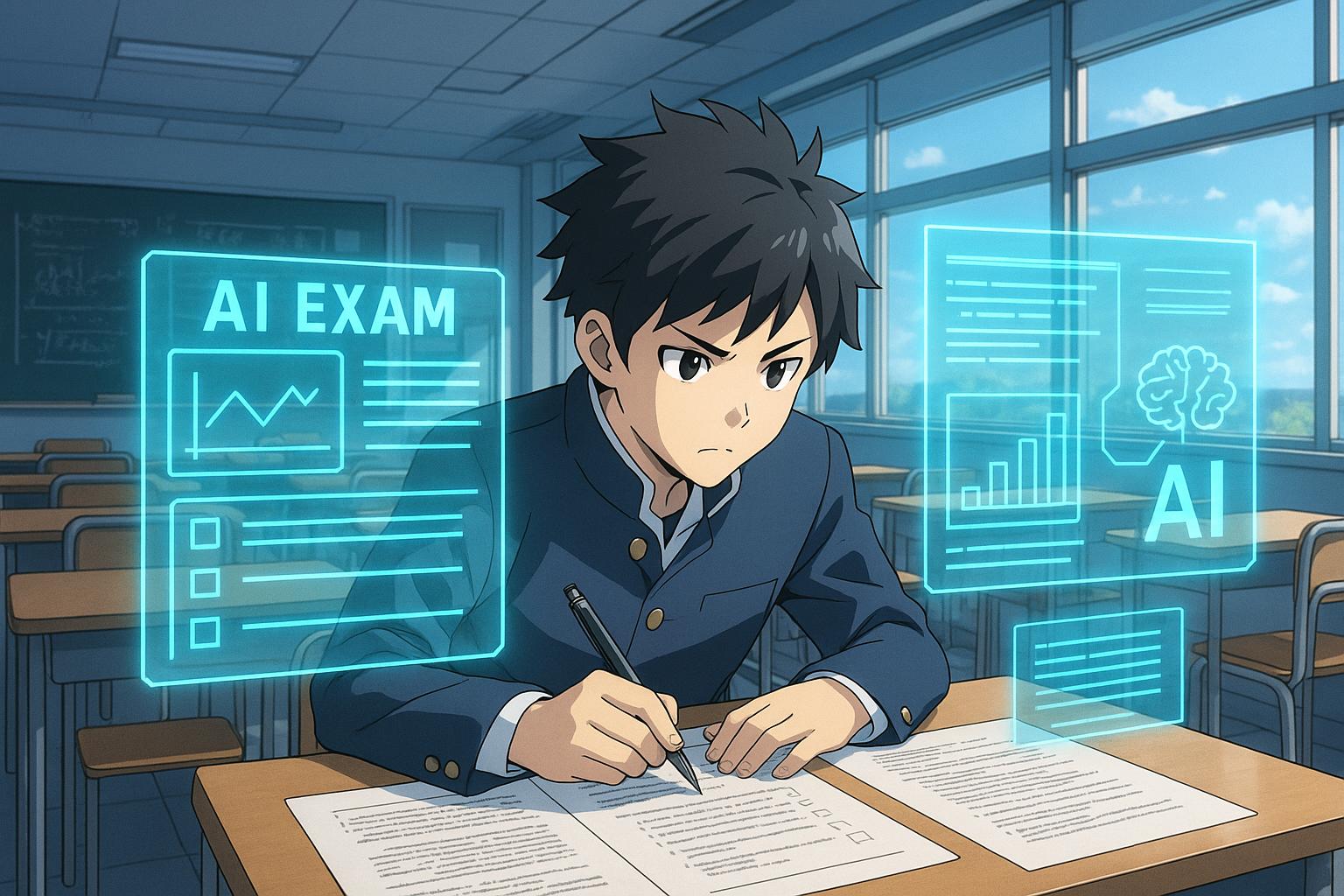With AI use in student assessments leaping to 88% among university students and 77% in teenagers, England’s education system faces a pivotal review. Educators and policymakers are urged to rethink teaching, exam formats, and grading to preserve integrity and harness AI’s potential.
The landscape of education assessment is evolving rapidly due to advancements in artificial intelligence, and the implications are profound. In less than a year since the announcement of a review of England’s curriculum and assessment system by Bridget Phillipson, it has become evident that generative AI is fundamentally reshaping how we approach educational evaluation. While some educators advocate for cautious adaptation to technological trends, the urgency of the situation suggests that educators can no longer afford to overlook these changes.
Recent statistics illustrate the dramatic uptick in AI usage among students; the percentage of university students utilising AI for assessments jumped from 53% in 2024 to an alarming 88% in 2025, while usage among 13- to 18-year-olds escalated from 37% to 77% in a single year. This surge raises critical questions about academic integrity and the authenticity of student work. Current AI detection tools are proving ineffective, often misclassifying original student submissions as plagiarised and failing to catch genuine instances of cheating. This scenario implies a concerning trend where students might rely on AI not as a supplementary tool but as a primary means to complete assignments, leading to a superficial educational experience where both educators and pupils are engaged in a façade of learning.
Given these challenges, there are several actionable steps that the curriculum and assessment review should consider to maximise the potential benefits of AI while mitigating its drawbacks. An essential first step is to evaluate existing AI marking systems rigorously. Diverse AI tools are entering the market, and conducting a comprehensive review will help understand their efficacy and reliability in an educational context.
Furthermore, the pervasive influence of AI necessitates a re-evaluation of initial teacher training programmes. Many educators operate under the misconception that leveraging AI in assessments is acceptable because it reflects real-world practices. However, it is crucial to realign the purpose of education with practices that genuinely enhance learning. The emphasis should shift from merely producing a polished final product generated by AI to understanding the processes students undertake to arrive at their conclusions. Thus, embedding training modules that clarify this distinction within existing curriculums is timely and essential.
In tandem with these educational reforms, there is a growing consensus that non-examined written assessments—increasingly susceptible to AI abuse—should be eliminated. Globally, educators are recognising that unsupervised writing tasks can no longer be regarded as viable. England’s exam-centric assessment framework provides a significant advantage in this area, but attention must be paid to independent schools that often employ unregulated qualifications and non-examined assessments that are particularly vulnerable to AI-induced plagiarism.
Moreover, revisiting the format of exams themselves could yield critical benefits. The idea of switching to digital assessments has gained traction, but considerations regarding the cognitive advantages of handwriting must not be overlooked. Handwritten exams can encourage students to engage more intimately with their work and deter them from inappropriate AI use, especially if they expect their final assessment to be conducted in this format. Some software tools, such as those offered by No More Marking, facilitate the transition from handwritten scripts to AI transcriptions, enhancing the assessment process while preserving the integrity of the original work.
The debate over how best to handle university admissions is also coming to the fore. The current practice of basing admissions on predicted grades is flawed and fails to reflect students’ actual abilities. By adopting actual grades at the time of university applications—facilitated by more effective AI grading systems—educators could establish a fairer admissions process.
In summary, AI has the capacity to widen inequalities in educational outcomes or, conversely, can serve as a powerful tool to bridge gaps, depending on how it is integrated into assessment frameworks. The forthcoming review by the Francis panel must navigate these complexities meticulously to leverage the ongoing technological evolution in a manner that enhances fairness and educational integrity.
The conversation surrounding AI in education is not solely about combating misuse; it equally involves embracing its potential as a transformative resource in teaching and learning. As educators adapt to this shifting landscape, the focus must remain steadfast on how best to utilise AI to enrich the learning experience while safeguarding the principles of academic honesty and student engagement.
Reference Map
- Paragraphs 1, 2, 3, 4, 5
- Paragraph 2
- Paragraph 1
- Paragraph 1
- Paragraph 2
- Paragraphs 3, 4
- Paragraph 1
Source: Noah Wire Services
- https://schoolsweek.co.uk/how-assessment-should-and-shouldnt-evolve-in-the-age-of-ai/ – Please view link – unable to able to access data
- https://www.ft.com/content/26ff910a-d19e-444b-9e4c-f06e6d546db3 – This article discusses the dual role of AI in education, highlighting its potential as both a teaching aid and a tool for academic dishonesty. It emphasizes the need for educators to understand AI’s capabilities to prevent misuse and to leverage its benefits in enhancing learning experiences. The piece also addresses the challenges posed by AI in maintaining academic integrity and suggests strategies for integrating AI responsibly into educational settings.
- https://time.com/6563787/american-students-skills-assessments-education/ – The article critiques the American K-12 education system’s overemphasis on standardized testing, proposing a shift towards skills-based assessments. It highlights the partnership between the Carnegie Foundation and ETS to develop tools that measure competencies like critical thinking and collaboration, aiming to provide a more engaging and equitable learning experience that aligns with real-world demands.
- https://www.ft.com/content/dd777c4e-31da-47bc-8241-91d39fe8020c – This piece explores AI’s transformative potential in education, focusing on personalized tutoring and support for educators. It discusses tools like Khanmigo from Khan Academy, which offer individualized educational support, and examines the benefits and challenges of integrating AI, including concerns about data privacy and the need for balanced implementation to maximize positive impacts.
- https://www.axios.com/2024/03/27/teachers-chatgpt-generative-ai-careers – A survey of over 1,000 K-12 teachers and administrators reveals divided opinions on AI’s impact on education. While some view AI as a tool for personalized learning and improved assessments, others express concerns about misinformation, cheating, and equity. The article highlights the need for clear policies and guidelines to navigate AI’s role in educational settings.
- https://arxiv.org/abs/2406.18900 – This academic paper examines the integration of AI in educational measurement, highlighting advancements like automated scoring and personalized feedback. It also addresses ethical concerns such as algorithmic bias and transparency, proposing guidelines to ensure responsible AI use in education and emphasizing the importance of ethical standards in AI-powered assessment tools.
- https://www.infosysbpm.com/blogs/education-technology-services/ai-in-education-assessments.html – The article discusses how AI is transforming educational assessments by automating grading, personalizing tests, and providing real-time insights into student progress. It highlights the benefits of AI-powered assessment tools, including efficiency, scalability, and the ability to offer personalized learning experiences, while also acknowledging challenges like ethical concerns and data privacy risks.
Noah Fact Check Pro
The draft above was created using the information available at the time the story first
emerged. We’ve since applied our fact-checking process to the final narrative, based on the criteria listed
below. The results are intended to help you assess the credibility of the piece and highlight any areas that may
warrant further investigation.
Freshness check
Score:
8
Notes:
The content references recent developments in AI usage among students and ongoing educational reforms, indicating a high level of freshness. However, the narrative does not include specific dates or events that might confirm it as entirely new.
Quotes check
Score:
10
Notes:
There are no direct quotes in the narrative, so there is no risk of duplicated or unverified quotes.
Source reliability
Score:
8
Notes:
The narrative originates from Schools Week, a reputable source within the educational sector, enhancing its reliability. However, the lack of diverse perspectives or academic citations may affect perceived credibility.
Plausability check
Score:
9
Notes:
The discussion about AI’s impact on education and assessment is plausible and aligns with current trends. The narrative raises valid concerns about academic integrity and AI use in assessments.
Overall assessment
Verdict (FAIL, OPEN, PASS): PASS
Confidence (LOW, MEDIUM, HIGH): HIGH
Summary:
The narrative appears fresh and relevant, addressing current challenges in education related to AI. It is plausible and well-reasoned, with a reliable source. The absence of direct quotes further supports its originality.













